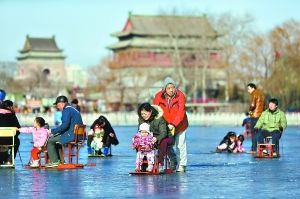This is News Plus Special English. I'm Marc Cavigli in Beijing.
Another piece of news about Beijing. Beijing has the warmest New Year's Day in six decades this year.
According to Beijing meteorological bureau, the highest temperature in the Chinese capital was 12.8 degrees Celsius at 2 pm on January 1st. It is the warmest New Year's Day since 1951.
This temperature was 8 degrees higher than the average of the past three decades.
However, the bureau says, although Beijing experienced a warmer New Year, it is still too early to say that this winter will be warmer than usual.
Meanwhile, doctors in the city have warned the possibility of respiratory problems may rise due to a lack of snowfall and low humidity.
December to January is Beijing's flu season. But so far, there is no report of an obvious increase of flu patients.
Outside Beijing, many parts of the country had experienced their warm New Year's Day.
In Hang-zhou in eastern China's Zhejiang Province, the temperature reached a record high of 16 degrees Celsius, and in He-fei in central China, the mercury rose to 17 degrees, breaking the previous high on Jan 1 by 9 degrees.

China has promised to adopt "the strictest" environment and energy policies as it has lagged behind in terms of four binding environmental targets set for 2015.
The four targets are for energy intensity, carbon dioxide emissions, rationalization of energy consumption and nitrogen oxide emissions.
In 2011 and 2012, the first two years of the plan period, China's energy intensity, or energy consumption per unit of gross domestic product, only dropped by about 6 percent. The target is a 16 percent reduction from 2010 to 2015.
The five-year plan aims to reduce the carbon intensity, or the amount of carbon produced per unit of GDP, by 17 percent from 2010 to 2015. In the first two years, it was only reduced by less than 7 percent.
The country also failed to gain a substantial increase in non-fossil energy in the first two years.
The emission of nitrogen oxides in 2011 and 2012, which closely affects air quality, increased by nearly 3 percent from the previous year. The target seeks to reduce 10 percent from 2010 to 2015.












